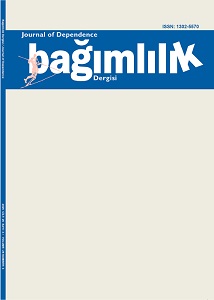Retrospective analysis of probationers: sociodemographic characteristics, individual and familial history of addiction and crime, and treatment outcomes
Keywords:
Illicit drug, toxicological analysis, crime, probationAbstract
Objective: The first Turkish drug treatment court was started in 2006. In this study, the files of the probationers who referred to our addiction center for a one year period were evaluated according to their sociodemographic characteristics, the history of personal and familial alcohol/drug use, the characteristics of personal substance related crimes and non-substance related crimes and familial criminal history. Toxicological analyses during the treatment period and treatment outcomes were evaluated also.
Method: The research is a decriptive and cross sectional study. Overall, one hundred and twenty nine files of probationers, who did not have comorbid mental disease, were evaluated. Data was analyzed by SPSS 15.0 statistics program.
Results: The 98.2% of subjects were male (n=128), 0.8% (n=1) of the sample was female. The mean age of the subjects was 33.1 ± 11.6 (18-69). Results of the toxicological analysis during the probation period showed that in 46.5% of the subjects no substance was detected; in 38.8% of the subjects marijuana; in 1.5 % of the subjects cocaine; in 1.5% of the subjects amphetamine, in 0.8% of the subjects opiate and in 0.8% of the subjects multisubstance was detected. The analysis of treatment outcomes showed that 46,5% of subjects had positive final reports.
Conclusion: This is the first study that evaluated the sociodemographic, personal and familial alcohol/substance use and criminal histories of the probationers who refered to mandatory treatment for substance use in Turkey. The growing knowledgeon thisissue may contribute to the development of the most proper treatment and prevention programsforthis population.
References
Nolan JL Jr. Drug treatment courts and the disease paradigm. Subst Use Misuse 2002; 37(12-13): 1723-50.
http://www.tbmm.gov.tr/kanunlar/k5237. html (18.06.2008 tarihinde ulaşılmıştır)
Altıntoprak AE, Akgür SA, Coşkunol H. Yasa dışı madde kullanımı nedeniyle denetimli serbestlik tedbiri uygulanan kişilerde tedavi uygulamaları ve toksikolojik analiz. Türkiye’de Psikiyatri 2007; 9: 166-172.
Hser YI, Evans E, Teruya C, et al. Predictors of short-term treatment outcomes among California’s Proposition 36 participants. Eval Program Plann 2007; 30: 187–196.
Coppola JJ. A commentary on “Urine testing in methadone maintenance treatment: applications and limitations”. J Subst Abuse Treat 2003; 25:65-66.
Heaps MM, Lurigio AJ. A commentary on “Urine testing in methadone maintenance treatment: applications and limitations”. J Subst Abuse Treat 2003; 25:69-70.
First MB, Spitzer RL, Gibbon M. et al. Structured clinical interview for DSM-IV clinical version (SCID-I/CV). Washington DC, American Psychiatric Pres 1997.
Özkürkçügil A, Aydemir O, Yıldız M, et al. DSM-IV eksen I bozuklukları için yapılandırılmış klinik görüşmenin Türkçeye uyarlanması ve güvenilirlik çalışması. Ilac ve Tedavi Dergisi 1999; 12: 233–6.
Altıntoprak AE, Akgür SA, Coşkunol H. Yasa Dışı Madde Kullanımı Nedeniyle Denetimli Serbestlik Tedbiri Uygulanan Kişilerde Tedavi Uygulamaları ve Toksikolojik Analiz Türkiye’de Psikiyatri 2007; 9:166-172.
Lo CC. Sociodemographic factors, drug abuse, and other crimes: how they vary among male and female arrestees. J Crim Justice 2004;32:399–409.
Akgoz S, Akkaya C, Berkay F, et al. Trends in the annual incidence rates of narcotics felons arrested over the last 30 years in metropolitan Bursa, Turkey. Tohoku J Exp Med. 2007; 212 (3): 253-63.
Adams BS, Olson DE, Adkins R. Results from the 2000 Illinois adult probation outcome study 2002. Retrieved March 2008, from Web site: http://www.icjia.state.il.us/public/ pdf/ResearchReports/2000Probation%20 Outcome%20Study.pdf
Macfadden W, Woody GE. Cannabis-related disorders. Comprehensive Textbook of Psychiatry. Seventh Edition, Vol. 1, Philadelphia: Lippincott Williams & Wilkins, 2000: 990–999.
Altıntoprak EA, Akgür SA, Yüncü Z, ve ark. Kadınlarda alkol kullanımı ve buna bağlı sorunlar. Türk Psikiyatri Dergisi 2008; 19: 197-208.
Ogel K, Corapcioglu A, Sir A, et al. Tobacco, alcohol and substance use prevalence among elementary and secondary school students in nine cities of Turkey. Turk Psikiyatri Dergisi 2004; 15:112-118
Tot S, Yazici K, Yazici A, et al. Psychosocial correlates of substance use among adolescents in Mersin,Turkey. PublicHealth2004;118:588–593.
Ögel K, Aksoy A. Tutuklu ve hükümlü ergenlerde madde kullanımı.BağımlılıkDergisi2007;8:11–17.
Copur M, Turkcan A, Erdogmus M. Substance abuse, conduct disorder and crime: assessment in a juvenile detention house in Istanbul, Turkey. Psychiatry Clin Neurosci. 2005; 59: 151-4.
DegenhardtL,HallW,LynskeyM.Alcohol,cannabis andtobaccouseamongAustralians:acomparison of their associations with other drug use and use disorders, affective and anxiety disorders, and psychosis; Addiction 2001; 96:1603–1614.
Gormana DM, Derzonb JH. Behavioral traits and marijuana use and abuse: A meta-analysis of longitudinal studies. Addict Behav 2002; 27: 193–206.
Schuckit MA, Li TK, Cloninger CR, Deitrich RA. Genetics of alcoholism. Alcohol Clin Exp Res 1985; 9:475-92.
Martin SE, Bryant K. Gender differences in the association of alcohol intoxication and illicit drug abuse among persons arrested for violent and property offenses. J Subst Abuse 2001; 13: 563-581.
Merikangas KR, Stolar M, Stevens DE, et al. Familial transmission of substance use disorders. Arch Gen Psychiatry 1998; 55:973-9.
Lochner L, Moretti E. The effect of education on crime: evidence from prison inmates, arrests and self-reports. National Bureau of Economic Research, Working Paper 8605, 2001. Retrieved June 2008, from Web site: http://www.nber. org/papers/w8605.pdf?new_window=1
Joe GW, Simpson DD, Broome KM. Effects of readiness for drug abuse treatment on client retention and assessment of process. Addiction 1998; 93:1177-90.
Simpson DD, Joe GW, Rowan-Szal GA, et al. Drug abuse treatment process components that improve retention. J Subst Abuse Treat 1997; 14:565-72.
Miles DR, Stallings MC, Young SE, et al. A family history and direct interview study of the familial aggregation of substance abuse: the adolescent substance abuse study. Drug Alcohol Depend. 1998; 49: 105-14.
Downloads
Published
Issue
Section
License
Copyright (c) 2025 Journal of Dependence

This work is licensed under a Creative Commons Attribution-NonCommercial-NoDerivatives 4.0 International License.
The Journal and content of this website is licensed under the terms of the Creative Commons Attribution-NonCommercial-NoDerivatives 4.0 International (CC BY-NC-ND 4.0) License. This is in accordance with the Budapest Open Access Initiative (BOAI) definition of open access. The Creative Commons Attribution-NonCommercial-NoDerivatives 4.0 International (CC BY-NC-ND 4.0) allows users to copy, distribute and transmit unmodified article, and make noncommercial use of the article. The CC BY license permits non-commercial re-use of an open access article, as long as the author is properly attributed.

